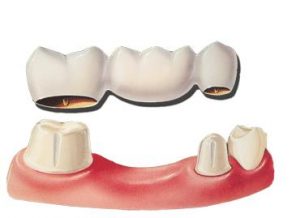What is Restorative Dentistry?
Restorative dental treatments encompass all of the disciplines that dentistry offers, integrating optimum oral health, full dental function and aesthetics. Dr. Malcomson’s 25+ years of experience in Cosmetic and Restorative Dentistry helps to achieve the best possible long-term results for every patient. When required, the incorporation of endodontic therapy, oral surgery, periodontal care, dental restorations, and orthodontics – in order for the patient to receive maximum benefits. A temporary ‘flipper’ can replace one or more teeth while the patient heals after extraction(s), prior to restoring with an implant and implant supported crown. A permanent bridge for three or more teeth, bone grafting and gum rebuilding are also restorative in nature.
 Bridges
Bridges
A fixed bridge is fabricated with two or more crowns as anchors. The bridge includes the adjacent teeth that surround the missing tooth – these ‘anchoring’ teeth are called abutment teeth. The space maintainer for the missing tooth is called a ‘pontic’. Fixed dental bridges are supported by natural teeth and / or dental implants. There are a few available materials used to fabricate fixed bridges, satisfying a patient’s esthetic concerns and comfort.
Watch a Short Patient Video
Crowns
When a crown is recommended, it is often needed to protect the patient’s remaining tooth structure,
and restore the tooth to it’s original shape and size by “capping” the tooth. A tooth that has been
weakened by decay; developed a crack or a fracture; one has experienced failure of a prior
restoration or a recent root canal, may require a crown.
Watch a Short Patient Video
Do I NEED a Crown after a Root Canal?

A crown may not be necessary after Root Canal Therapy (RCT). Dr. Malcomson may recommend a crown to protect the weakened tooth after RCT and to protect the tooth by providing additional strength of a crown. A crown seals the tooth and helps to prevent infection and further decay. There are a variety of materials used to fabricate a crown. Strong dental ceramics such as zirconia and porcelain have a natural, tooth-colored appearance, but gold / metal is also an option. A treatment plan will be provided to the patient when Dr. Malcomson recommends this type of restorative procedure. After crown or bridge work, an occlusal guard should be worn at night to protect your investment from unexpected breakage during sleep.
Implant Crowns

A dental implant is an alternate method of replacing a tooth that required extraction. An implant can replace one single tooth, multiple teeth or can be used to support a fixed bridge, denture and partial denture. This type of restoration consists of two stages: extraction of the tooth in question, followed by placement of an implant by a Periodontist or Oral Surgeon. Once the specialist has released the patient, he/she may then return to Malcomson Dentistry for the next step of the restoration process, which is an impression to replace the missing tooth.
The first stage of the restoration involves placing a dental implant and allowing time for the implant to fuse to the bone. Once fully healed, Dr. Malcomson will take an impression to fabricate your custom abutment and implant crown. The custom abutment is inserted directly onto the implant and the crown is then placed. A referral and a Treatment Plan will be provided to all Malcomson Dentistry patients for restorative procedures.
Duration of the Procedure
The duration of the procedure varies because healing time is required between the stages of extraction to placement of the crown. When there is adequate bone, gum tissue and the patient is in good health, a specialist may offer “immediate loading.” Most commonly, the crown is placed several months after extraction and implant placement, allowing an implant adequate time to fuse with the jawbone. In cases involving bone grafting, the graft must first heal for several months before the implant can be placed. The implant must then integrate into the bone for several months before the crown can be adhered to the implant.

Implant Placement Procedure
While there is some variation in restorative procedures, the following steps are required for dental implant placement. The first portion of the procedure is done at your specialist’s office. The gum covering the area is gently folded back and the underlying bone prepared to receive the implant. The extent of the bone preparation is dependent on the number of implants required. The implant(s) are placed and the gum area sutured. The implant should fully integrate into the bone after 3 to 6 months. At this point, a custom-designed crown is fitted over the post. The details of the procedure change slightly with the structure of the implant used.
 Composite fillings “match” the shade of a patient’s natural tooth. Composite can be used to restore a chipped, cracked, discolored or misaligned tooth by rebuilding the surface. Composite strengthens the tooth after the defect or decay is repaired. It also restores the area of decay, protecting the tooth from potential future decay. Dental technology continues to make improvements to ‘composite’ material, by way of; strength, durability and increased selection of colors. This natural tooth-colored material adheres to the tooth surface better than amalgam and Patients will no longer see a color difference when they open their mouth.
Composite fillings “match” the shade of a patient’s natural tooth. Composite can be used to restore a chipped, cracked, discolored or misaligned tooth by rebuilding the surface. Composite strengthens the tooth after the defect or decay is repaired. It also restores the area of decay, protecting the tooth from potential future decay. Dental technology continues to make improvements to ‘composite’ material, by way of; strength, durability and increased selection of colors. This natural tooth-colored material adheres to the tooth surface better than amalgam and Patients will no longer see a color difference when they open their mouth.
Watch a Short Patient Video
Valplast
Replacing an extracted / missing tooth will restore a Patient’s jaw and bite to its proper functioning, while supporting facial tissue and tooth structure. Valplast was developed to provide patients a precise fit and the strength needed for a metal-free denture. Unlike metal, Valplast blends naturally with the color of a patient’s gum. If this is an option for you, an impression should be taken no earlier than two weeks after the extraction.
Watch a Short Patient Education Video
Interim Denture (Flipper)
Following an extraction, while waiting for the gum and bone to heal (prior to an implant and implant crown restoration). A Patient may elect to have an interim denture fabricated. A ‘flipper’ is the least expensive way to temporarily replace a missing tooth. The flipper is typically made made from acrylic, fabricated to match the shade of your natural teeth. Consult with Dr. Malcomson to determine if this is a possible option for you. If so, an impression will be taken and a lab will fabricate the flipper, so that it can be placed by the specialist, on the same day as the extraction.
Watch a Short Patient Education Video

Removable Partial Denture
This removable denture can be made with acrylic and sometime with lightweight metal clasps and framework. Lightweight resin material and metal is used in combination for increased retention. The framework’s function is often secure when used in conjunction with two to four dental implants. Replacement teeth are fabricated with acrylic, offering more shade selections, creating a natural appearance with greater wear, in addition to the benefits of strength and function.
Watch a Short Patient Video

Removable Full Denture
When it becomes necessary that a patient’s remaining teeth should require removal, a full denture may be the best treatment plan for a patient. While the denture is a removable appliance, it is utilized to replace missing teeth and restore a patient’s smile. If you’ve lost most of your natural teeth, whether from gum disease, tooth decay or injury; replacing missing teeth will re establish your natural appearance and your overall health. Dentures facilitate chewing and speaking – things that we often take for granted. Without, facial muscles begin to sag, and facial structure can alter ones appearance. A denture can be made to closely resemble your natural teeth, so that your appearance does not change much. Dentures may even improve the look of your smile!
Watch a Short Patient Video
Veneers

Are you a Candidate for Veneers?
Veneers are bonded to a patient’s natural tooth. Dental veneers or dental (resin) laminates are wafer-thin, custom-made shells of tooth-colored material, designed to cover the front surface of a tooth. The color, shape, size, and/or length of the teeth is meant to improve the aesthetic appearance of your smile. Veneers can be lab fabricated from porcelain or made in office with a resin composite material. Porcelain veneers resist stains better than resin, mimicking the light reflecting properties of a natural tooth. A resin veneer is thinner and requires less removal of the natural tooth surface before placement.
Discoloration from root canal treatment; stains from tetracycline or other drugs; excessive fluoride; or the presence of large resin fillings can discolor a tooth. Veneers can help if teeth are worn down, chipped, broken, misaligned, uneven, and irregularly shaped. Gaps between teeth can be closed with placement of a veneer.
Easy as 1, 2, 3…
Diagnosis and Treatment Planning – This first step involves a patient’s active participation. Share with your Dentist the result(s) that you are looking to achieve. During your consultation, Dr. Malcomson will examine your teeth to ensure dental veneer(s) are appropriate and discuss the procedure. If a Patient would like to whiten their teeth, now is the time!
1. Prepare teeth, take impressions and color match.
2. The lab fabricates your veneers, Dr. Malcomson will adhere the veneers. Whether you choose one or multiple teeth, they can simultaneously undergo the veneering process described below.
-
Preparation – Dr. Malcomson will remove approximately .05mm of enamel from the tooth’s surface, which is equal to the thickness of the veneer to be placed. Next, a model or impression will be taken. The model is delivered to a local dental laboratory, which in turn fabricates your veneer(s). In approximately two weeks, Malcomson Dentistry receives the completed veneer(s) from the lab. *For unsightly teeth, temporary veneers can be placed by the Dentist.
-
Bonding – Prior to cementing the veneer(s), Dr. Malcomson will temporarily adhere to your tooth, examining the fit, size and color. She may remove and trim the veneer (as needed, to achieve the proper fit). Dr. Malcomson will prepare the tooth to receive the veneer, roughening the tooth, to allow for a strong bond. Once properly positioned on the tooth, a curing light is used to activate the dental cement, causing it to harden and cure. The final steps involve; removing excess cement; evaluating your bite; and making any final adjustments in the veneer(s). You will be asked to make a follow-up visit in a few weeks to check how your gums are responding to the presence of your veneer(s), along with placement.






